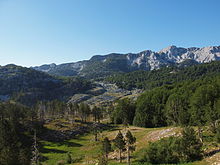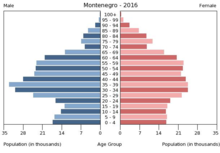Montenegro
![]()
This article is about the state in Southeastern Europe. For other meanings, see Montenegro (disambiguation).
Template:Infobox State/Maintenance/NAME-German
Montenegro (Montenegrin or Bosnian/Croatian/Serbian Црна Гора/Crna Gora [ˈt͡sr̩naː ˈɡɔra], Albanian Mali i Zi) is a republic on the southeastern Adriatic coast in southeastern Europe. Montenegrin territory borders Croatia to the northwest (25 km), Bosnia and Herzegovina (225 km), and Serbia to the northeast (124.4 km), Kosovo to the southeast (78.6 km), and Albania to the south (172 km). Montenegro became independent again on 3 June 2006; previously it had been part of Yugoslavia since 1920.
With about 625,000 inhabitants and an area of 13,812 square kilometres, the Balkan state is one of the smaller states in Europe - somewhat smaller than Schleswig-Holstein. The capital and largest city is Podgorica, second largest city is Nikšić. The main economic sectors are the service sector and tourism, especially on the Montenegrin coast.
Montenegro is a member of the United Nations, the WTO, the OSCE, the Council of Europe and NATO. Montenegro is a candidate for accession to the European Union; it uses the euro as its currency.
Country
Etymology
Montenegro, from Venetian montagna negra, means "black mountain". The self-designation Crna Gora can mean "black mountain", "black forested mountain" or "black forest".
Geography
→ Main article: Geography of Montenegro
Montenegro is a relatively sparsely populated, forested mountain country in the southeastern part of the Dinaric Mountains. The inaccessible high mountains are divided by steep, forbidding canyons. Among them, the Tara Gorge is considered the deepest gorge in Europe. Therefore, only the valley of the Lim, characterized by numerous widenings, is more densely populated.
Only in the southeast Montenegro is characterized by lowlands. In the cryptodepression of Lake Scutari and the lowlands of the lower Morača and Cijevna lie its most fertile areas; among other things, the country's typical red wine Vranac is grown there.
The numerous polje are of particular importance. The Nikšić polje is the largest and most densely populated. In addition to the typically Central European beech, fir and spruce forests of Central Montenegro, which are among the most species-rich forests in Europe, especially with their abundance of trees (among others, the mountain forests of Montenegro contain the endemic-relict tree species Greek maple, snakeskin pine, Rumelian pine and tree-hazel), Mediterranean hardwood forests with holm oak and Macedonian oak are also represented. At Lake Scutari there are typical riparian forests with English oak and softwood floodplains. The primeval forests of the national parks at Durmitor and Biogradsko jezero in the Belasica are a retreat and habitat for predators such as wolf, brown bear and lynx.
The country can be divided into three main landscape areas from southwest to northeast:
- the steeply sloping cliffs on the Mediterranean (Adriatic) coast, divided by bays (e.g. Bay of Kotor), with the historic Mediterranean coastal towns,
- the barren and waterless karst plateau of Old Montenegro (Rudine, Banjani and the Katunska nahija with the highest coastal mountain range in Dalmatia, Orjen with Zubački kabao (1894 m) and Lovćen). Here, only a few poljen offer some arable land (Grahovo, Cetinje),
- as well as the deeply divided by canyons (Tara canyon, Piva canyon), repellent northern Montenegrin high mountain country. Here are the highest elevations of Montenegro and the entire Dinaric mountains the Prokletijemassiv with the highest elevation of the country, the Zla Kolata (2534 m) as well as the Durmitor massif with the Bobotov Kuk (2522 m). The Durmitor (glacier Debeli namet) and especially the Prokletije (Jezerce Peak, Zla Kolata, Karanfil) are the only mountains of the Balkan Peninsula where numerous firn fields and smaller glaciers (up to 350 m long and 300 ha in extent) still persist throughout the year. During the Pleistocene cold phases Montenegro was the most glaciated area in southern Europe. Recent Quaternary research on geological events during the glacial period in the southeastern Dinarides has provided evidence of a previously suspected massive glaciation of Montenegro during the Mindel Ice Age. Even in the sub-Adriatic Orjen, an ice sheet up to 400 m thick and the presence of numerous outlet glaciers reaching to the edge of the Bay of Kotor on the Adriatic coast have been documented for the Mindel epoch. As a result of large-scale glaciation, the high mountains of Montenegro are typically characterized by forms of glacial morphology such as glacial lakes, moraines, trough valleys, escarpments and cirques. To this day, they are also a refuge of glacial flora such as the glacial relicts silverwort (Dryas octopetala) and edelweiss (Leontopodium alpinum). The occurrence of Dryas has even been documented on Bijela gora not far from the Adriatic coast, where otherwise predominantly Mediterranean high mountain plants are found.

A betony of the Illyrian Floral Province in the sub-Adriatic Orjen (to Betonica serotina s. l.)

Montane fir-beech and subalpine maple-beech forests of Bijela gora. In the left foreground black pine

Oro-Mediterranean stage on the glacially overprinted Pazua ridge (Velje leto) in Orjen. Habitat for Crimean peony and Orjen iris.
Population
Ethnicities
The population of Montenegro, like that of many states in Southeastern Europe, is multi-ethnic. In the 2011 census, 278,865 people or 44.98% of the population identified themselves as Montenegrins, 178,110 or 28.73% as Serbs, 53,605 or 8.65% as Bosniaks, 30,439 or 4.91% as Albanians, 20.537 or 3.31% as Muslims (in the ethnic sense), 6251 or 1.01% as Roma, 6021 or 0.97% as Croats and 47,513 or 7.68% indicated another or no nationality or did not provide any data at all.
The Serbs make up the majority of the population, especially in areas in the north of Montenegro on the border with Serbia and on the border with Bosnia and Herzegovina. In the coastal city of Herceg Novi, they make up the majority of the population. Bosniaks and Slavic Muslims live mainly in the northeast, around Plav and Rožaje in the tri-border area of Serbia, Kosovo and Albania. Another minority are the Albanians, who live mainly in the areas along the border with Albania and Kosovo. In the municipality of Ulcinj they make up the majority of the population with 71 per cent (2011 census).
Furthermore, there are displaced persons living in Montenegro who are not included in the census because they have refugee status. These are 6,926 mostly Serb refugees from Bosnia and Herzegovina and 16,137 refugees from Kosovo (mostly Roma and Serbs).
Life expectancy in Montenegro in the period from 2010 to 2015 was 76.4 years (men: 74.0 years, women: 78.8 years), according to the UN.
Languages
According to the Constitution of 19 October 2007, the official languages of Montenegro are Montenegrin, Serbian, Bosnian, Albanian and Croatian. In contrast, Article 11 of the Law on Minorities, adopted on 11 May 2006, allows the use of minority languages as official languages only in municipalities where the minority in question constitutes the majority or a significant part of the population, which gives some leeway to the Montenegrin authorities. The 2002 Law on Minorities of the State Union of Serbia and Montenegro, on the other hand, stipulated that the share of a minority in the total population of a municipality had to be at least 15 per cent according to the last census in order for its language to be recognised as an official language at the municipal level.
Both the Latin and Cyrillic alphabets are in use. Especially in the tourist coastal regions, the Cyrillic alphabet is increasingly being replaced by the Latin script.
With regard to the name of the language, there are differing opinions among the population, just as there are with regard to the nationality designation. In the 2011 census, 42.9 per cent of the population reported Serbian and 37 per cent Montenegrin as their mother tongue. Bosnian and Albanian each accounted for 5.3 per cent as their mother tongue.
According to a 2014 survey involving 1001 people, respondents named the language they spoke as follows:
- 41.1 % Montenegrin
- 39.1 % Serbian
- 11,5 % Montenegrin and Serbian (same language, whatever it is called)
- 3.7 % Bosnian
- 3.5 % Serbo-Croatian
- 1.1 % Croatian
Religions
72 per cent of the inhabitants of Montenegro belong to the Serbian Orthodox Church, whose Metropolitan is Amfilohije Radović. (→ List of bishops of Montenegro) In addition, there is the ecumenical Autocephalous Church of Montenegro, which was founded in 1993 and is not canonically recognized by the Orthodox Church. In addition to the Orthodox believers, there is a Muslim Sunni minority comprising about 16 percent of the population and, especially in the coastal towns, several thousand Catholics, mainly Croats and Albanians. The members of various Protestant communities number less than 1000 each. Since the beginning of 2012, Judaism has been considered the fourth official religion of the country. There is a Jewish community with about two hundred members.
Population development
| Year | Population |
| 1950 | 395.000 |
| 1960 | 487.000 |
| 1970 | 520.000 |
| 1980 | 581.000 |
| 1990 | 615.000 |
| 2000 | 614.000 |
| 2010 | 624.000 |
| 2017 | 629.000 |
Source: UN

Mosque in Dacići above Rožaje

Serbian Orthodox Resurrection Cathedral in Podgorica, largest Orthodox church in Montenegro

Distribution of ethnic groups by municipality 2011

Population pyramid of Montenegro 2016
Search within the encyclopedia